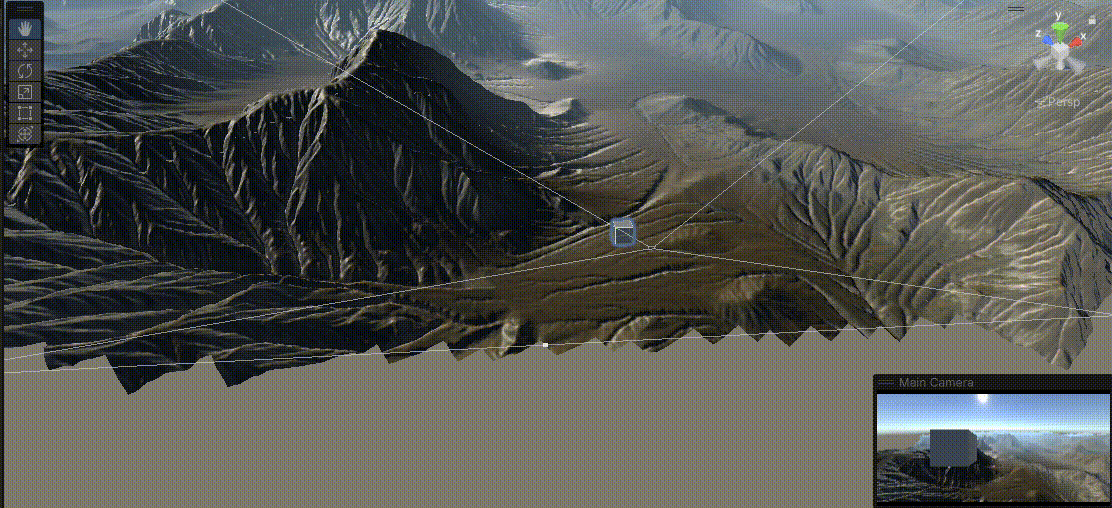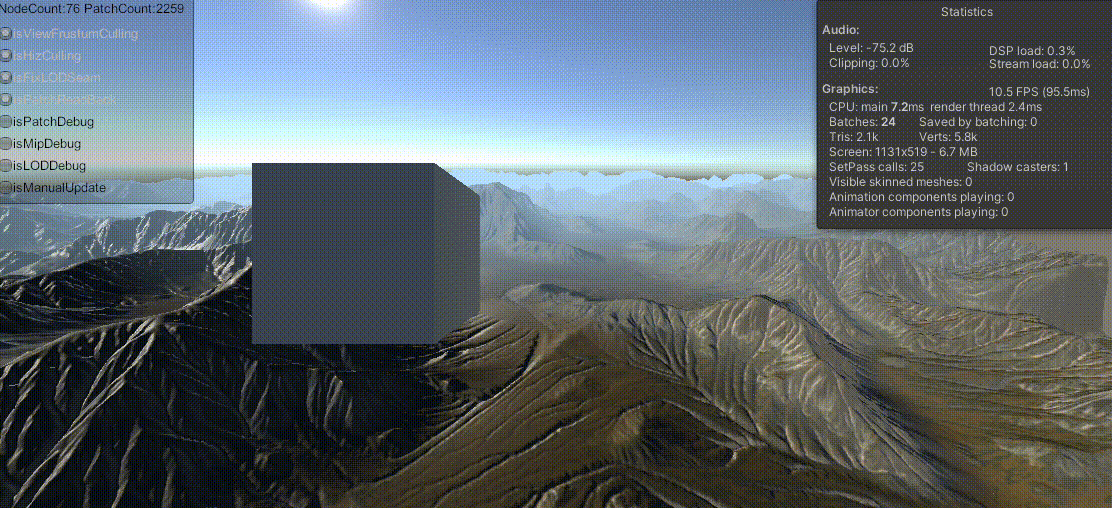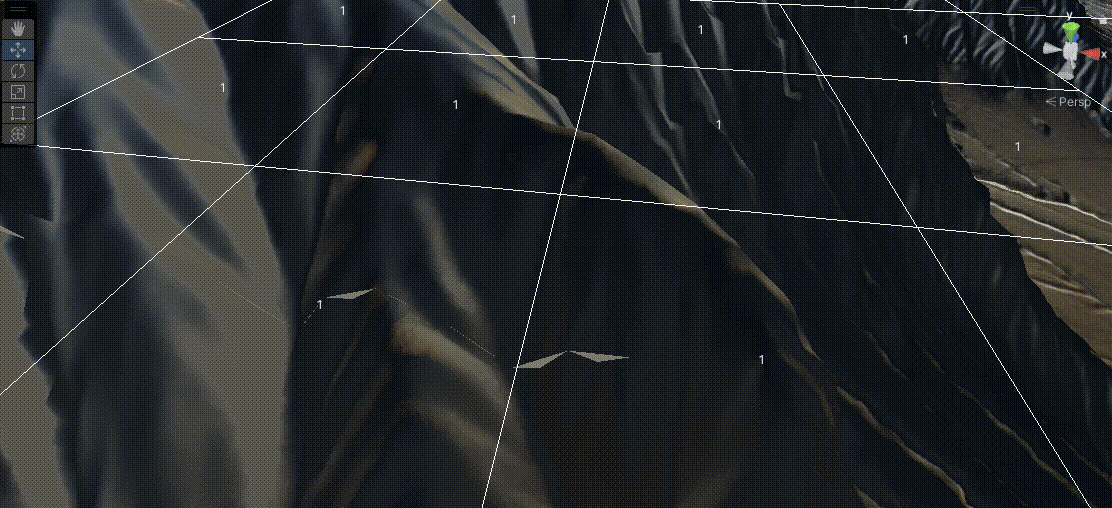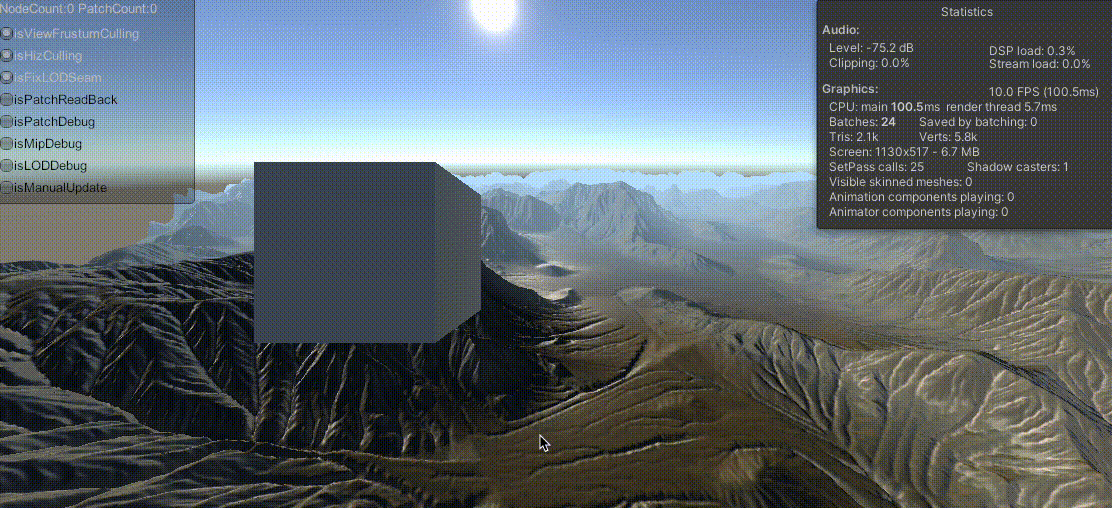简介
GPU Driven顾名思义,所有信息由GPU处理计算或渲染
很多文章也有介绍,这里记录下自己的一个思路
先看下效果图

用的Unity商城免费的资源
Terrain转高度图
这里我用了4个原生Unity地形,大小1024x1024
拼成了一个2x2,大小为2048x2048的高度图
int terrainNum = terrains.Length;
int splitNumX = 2;
int heightSize = (int)terrains[0].terrainData.size.x;
if (!Mathf.IsPowerOfTwo(heightSize))
{
Debug.LogError("heightSize is not PowerOfTwo");
return;
}
var realHeightSize = Mathf.NextPowerOfTwo(heightSize);
int totalHeightSize = realHeightSize * terrainNum / splitNumX;
float[] pixelData = new float[totalHeightSize * totalHeightSize];
heightMap = new Texture2D(totalHeightSize, totalHeightSize, TextureFormat.RFloat, false);
maxHeight = terrains[0].terrainData.heightmapScale.y;
for (int k = 0; k < terrainNum; k++)
{
var terrain = terrains[k];
var offsetX = (k % splitNumX) * heightSize;
var offsetY = ((k / splitNumX)) * heightSize;
for (int i = 0; i < heightSize; i++)
{
for (int j = 0; j < heightSize; j++)
{
pixelData[offsetX + i + (j + offsetY) * totalHeightSize] =
terrain.terrainData.GetHeight(i, j) / maxHeight;
}
}
}
heightMap.SetPixelData(pixelData, 0);
heightMap.Apply();创建Mesh
准备一个平铺的网格,这里我们用一个8x8,单位1米
这里用顶点索引,可以用最少的顶点数量去生成
private Mesh CreateQuardMesh(int size, float gridSize = 1)
{
_gValue._PerPacthGridNum = Convert.ToInt32(size / gridSize);
int gridSizeX = Convert.ToInt32(size / gridSize);
int gridSizeY = Convert.ToInt32(size / gridSize);
Mesh mesh = new Mesh();
Vector3[] vertices = new Vector3[(gridSizeX + 1) * (gridSizeY + 1)];
for (int x = 0; x <= gridSizeX; x++)
{
for (int y = 0; y <= gridSizeY; y++)
{
float posx = (float)x * gridSize;
float posz = (float)y * gridSize;
vertices[y * (gridSizeX + 1) + x] = new Vector3(posx, 0, posz);
}
}
int[] triangles = new int[gridSizeX * gridSizeY * 6];
for (int i = 0; i < gridSizeX; i++)
{
for (int j = 0; j < gridSizeY; j++)
{
int triIndex = (j * gridSizeX + i) * 6;
triangles[triIndex] = j * (gridSizeX + 1) + i;
triangles[triIndex + 1] = (j + 1) * (gridSizeX + 1) + i;
triangles[triIndex + 2] = (j + 1) * (gridSizeX + 1) + i + 1;
triangles[triIndex + 3] = (j + 1) * (gridSizeX + 1) + i + 1;
triangles[triIndex + 4] = j * (gridSizeX + 1) + i + 1;
triangles[triIndex + 5] = j * (gridSizeX + 1) + i;
}
}
mesh.vertices = vertices;
mesh.triangles = triangles;
mesh.RecalculateNormals();
mesh.RecalculateTangents();
return mesh;
}创建地形
准备数据
首先我们会根据_SplitNum=4参数,切割整个地形
_SplitNum表示边长,_SplitNum*_SplitNum才是会切割地形的块数
public struct NodeInfoStruct
{
public int CurLOD;
public int NodeNum;
public int Offset;
public int NodeSize;
public int PacthSize;
public int VertexScale;
public int HeightMipLevel;
}每一块就是一个Node,然后Node也会切成固定数量的Pacth,一个Pacth可以表示成一个Mesh
比如这块地形是2048x2048,我们_MAXLOD=3,一个Node可以分成8x8个Pacth
LOD3 Node数量4x4 NodeSize=512x512 PacthSize=64x64
LOD2 Node数量8x8 NodeSize=256x256 PacthSize=32x32
LOD1 Node数量16x16 NodeSize=128x128 PacthSize=16x16
LOD0 Node数量32x32 NodeSize=64x64 PacthSize=8x8
本来一个Mesh是8x8大小,如果LOD大于0,我们就需要把Mesh放大
我们会用到GPU Instance技术, DrawMeshInstancedIndirect把所有的Pacth渲染出来
TraverseQuadTree
这里我们用Compute Shader
根据_MAXLOD大小,判断当前的Node是否可以再细分
EvaluateNode函数很简单,就是到相机的dst/nodeSize/(一个你自定义的系数)
[numthreads(1, 1, 1)]
void TraverseQuadTree(uint3 id : SV_DispatchThreadID)
{
uint2 nodeXY = _ConsumeList.Consume();
const NodeInfoStruct nodeLOD = _NodeStructs[_CurLOD];
const int nodeIndex = nodeLOD.Offset + nodeXY.y * nodeLOD.NodeNum + nodeXY.x;
if (_CurLOD > 0 && EvaluateNode(nodeXY, nodeLOD.NodeSize))
{
nodeXY *= 2;
_AppendList.Append(nodeXY);
_AppendList.Append(nodeXY + uint2(0, 1));
_AppendList.Append(nodeXY + uint2(1, 0));
_AppendList.Append(nodeXY + uint2(1, 1));
_NodeBrunchList[nodeIndex] = 1;
}
else
{
_AppendFinalNodeList.Append(uint3(nodeXY, _CurLOD));
_NodeBrunchList[nodeIndex] = 2;
}
}
数字表示LOD
CreateNodeSectorMap
记录整个Node节点的LOD信息,纹理大小是LOD0的节点数,也就是32x32
用于填补Mesh在不同LOD后产生的缝隙
[numthreads(8,8,1)]
void CreateNodeSectorMap(uint3 id : SV_DispatchThreadID)
{
const uint2 sectorXY = id.xy;
// [unroll]
for (int lod = _MAXLOD; lod >= 0; lod--)
{
//当前所属LOD的节点XY
uint2 nodeXY = sectorXY >> lod;
const NodeInfoStruct nodeInfo = _NodeStructs[lod];
const int nodeIndex = nodeInfo.Offset + nodeXY.y * nodeInfo.NodeNum + nodeXY.x;
//该节点没有被拆分
if (_NodeBrunchList[nodeIndex] == 2)
{
_NodeSectorMap[sectorXY] = lod;
return;
}
}
_NodeSectorMap[sectorXY] = 0;
}CreatePatch
先看下完整代码
[numthreads(8, 8, 1)]
void CreatePatch(uint3 id : SV_DispatchThreadID, uint3 groupId:SV_GroupID, uint3 groupThreadId:SV_GroupThreadID)
{
uint3 nodeLODInfo = _FinalNodeList[groupId.x];
RenderPatch renderPatch=(RenderPatch)0;
const uint2 nodeXY = nodeLODInfo.xy;
const uint2 patchXY = groupThreadId.xy;
renderPatch._wpos.z = nodeLODInfo.z;
const NodeInfoStruct nodeInfo = _NodeStructs[renderPatch._wpos.z];
const uint2 nodePos = nodeInfo.NodeSize * nodeXY;//Node世界坐标
const uint2 patchPosInNode = nodeInfo.PacthSize * patchXY;//Pacth本地坐标(相对于Node)
renderPatch._wpos.xy = nodePos + patchPosInNode;//Pacth世界坐标
const float3 wpos = float3(renderPatch._wpos.x, 0, renderPatch._wpos.y);
//nodeXY * _PerNodePacthNum + patchXY 获取高度图的像素位置
float2 minMaxHeight = _HeightMapRT.mips[nodeInfo.HeightMipLevel][nodeXY * _PerNodePacthNum + patchXY].xy;
const float3 boundMin = float3(0, minMaxHeight.x * _max_height, 0);
const float3 boundMax = float3(nodeInfo.PacthSize, minMaxHeight.y * _max_height, nodeInfo.PacthSize);
Bounds bounds;
bounds.minPosition = wpos + boundMin;
bounds.maxPosition = wpos + boundMax;
#if _VIEW_FRUSTUM_CULLING
if (IsFrustumCulling(bounds, _ViewFrustumPlane))
return;
#endif
#if _DEBUG_MIP
renderPatch._wpos.w = GetBoundsMip(bounds);
#endif
#if _HIZ_CULLING
if (IsHizCulling(bounds))
return;
#endif
SetLODTrans(renderPatch, nodeXY, patchXY, nodeInfo);
_CulledPatchList.Append(renderPatch);
}计算出Pacth的世界坐标,判断是否需要视锥剔除,Hiz剔除,
struct RenderPatch{uint4 _wpos;uint4 _lodTrans;};
_wpos.xy世界坐标
_wpos.z Patch的LOD
_wpos.w 当前的Mip信息
HeightMinMaxMap
LOD(N)一个像素代表LOD(N-1)4个像素,这个4个像素高度可能都不一样,我们需要算出最高和最低的,保证精度不丢失
高度图所生成的depth大小为LOD0时,Pacth的数量,也就是高度图的大小**等于**Pacth的大小
也就是一个Pacth等于高度图里面的一个像素
Node里面有一个HeightMipLevel,这个值就是当前Node的Pacth的大小相同的高度图的depth
nodeXY * _PerNodePacthNum + patchXY 获取高度图的像素位置
这样就可以获得每个Pacth的最大最小高度,方便进行计算
[numthreads(8, 8, 1)]
void BuildMinMaxHeightMapByMinMaxHeightMap(uint3 id : SV_DispatchThreadID)
{
const uint2 uv = id.xy * 2;
const float2 h1 = inputMinMaxHeightMap[uv];
const float2 h2 = inputMinMaxHeightMap[uv + uint2(1, 0)];
const float2 h3 = inputMinMaxHeightMap[uv + uint2(0, 1)];
const float2 h4 = inputMinMaxHeightMap[uv + uint2(1, 1)];
float hMin = min(min(h1.x, h2.x), min(h3.x, h4.x));
float hMax = max(max(h1.y, h2.y), max(h3.y, h4.y));
outputMinMaxHeightMap[id.xy] = float2(hMin, hMax);
}FrustumCulling
Unity默认不是有视锥剔除吗?没错是的,这里我们还需要做一次,因为GPU Instace这种模式,Unity不会帮你做剔除
使用Unity的api,获取视锥的6个面GeometryUtility.CalculateFrustumPlanes顺序是左右上下远近
得到一个平面的法线,和这条法线距离相机的距离,并且法线是朝视锥体内
根据Pacth的最大和最小的高度,组成一个包围盒
struct Bounds{float3 minPosition;float3 maxPosition;};
分别判断这个包围盒minPosition和maxPosition离平面最近的那个点,是否在视锥6个面中
判断方法就用平面公式
bool IsFrustumCulling(Bounds bounds, float4 planes[6])
{
const float3 minPosition = bounds.minPosition;
const float3 maxPosition = bounds.maxPosition;
[unroll]
for (int i = 0; i < 6; i++)
{
float3 p = minPosition;
float3 normal = planes[i].xyz;
//需要获取距离平面最近的坐标
if (normal.x > 0)
p.x = maxPosition.x;
if (normal.y > 0)
p.y = maxPosition.y;
if (normal.z > 0)
p.z = maxPosition.z;
if (IsOutSidePlane(planes[i], p))
{
return true;
}
}
return false;
}
bool IsOutSidePlane(float4 plane, float3 position)
{
return dot(plane.xyz, position) + plane.w < 0;
}来看下效果,4800+Pacth降低到了2800+


#if UNITY_EDITOR
_terrainGPUDriven.Draw(cmd, Camera.main);
renderCallBack(cmd);
#else
_terrainGPUDriven.Draw(cmd, renderingData.cameraData.camera);
#endif顺便发现renderingData.cameraData.camera 在Game和Scene,会自动调整到对应的相机坐标
Camera.main 只会获取到Game下的坐标
HizCulling
先看代码
bool IsHizCulling(Bounds bounds)
{
Bounds boundsUVD = CalBoundUVD(bounds);
const float2 size = (boundsUVD.maxPosition.xy - boundsUVD.minPosition.xy) * _HizMapSize.xy;
uint2 mipXY = ceil(log2(size));
//max(mipXY.x, mipXY.y)正方形
const uint mip = clamp(max(mipXY.x, mipXY.y), 0, _HizMapSize.z);
const uint2 mipHizMapSize = (uint2)_HizMapSize.xy >> mip;
float d1 = SampleHizMap(boundsUVD.minPosition.xy, mip, mipHizMapSize);
float d2 = SampleHizMap(boundsUVD.maxPosition.xy, mip, mipHizMapSize);
float d3 = SampleHizMap(float2(boundsUVD.minPosition.x, boundsUVD.maxPosition.y), mip, mipHizMapSize);
float d4 = SampleHizMap(float2(boundsUVD.maxPosition.x, boundsUVD.minPosition.y), mip, mipHizMapSize);
#if _REVERSE_Z
float depth = boundsUVD.maxPosition.z;
return d1 > depth && d2 > depth && d3 > depth && d4 > depth;
#else
float depth = boundsUVD.minPosition.z;
return d1 < depth && d2 < depth && d3 < depth && d4 < depth;
#endif
}CalBoundUVD就是求出NDC空间下包围盒坐标信息
怎么求NDC系坐标?
inline float3 CalPointUVD(float3 pos)
{
float4 clipSpace = mul(_VPMatrix, float4(pos, 1.0));
float3 uvd = clipSpace.xyz / clipSpace.w;
uvd.xy = (uvd.xy + 1.0) * 0.5;
return uvd;
}乘以VP矩阵,换算到投影坐标,除以w就是NDC坐标了范围[-1,1],再转换到[0,1]之间
乘以我们的Mip0的_HizMapSize
再log2以下就可以求出所需要采样的mip
为什要log2?比如算出物体在Mip0大小为128,我们需要取得它在那个mip下可以表示为1个像素
答案很显然,2的7次方就是log2(128),我们最后采样一个2x2大小深度算一下就行
为啥要2x2?因为我们算出来的是包围盒,一个小正方形
看下效果,2800+降低到2300+

再来个俯视图

生成HizMap,我们放在RenderPassEvent.BeforeRenderingSkybox
这样就会记录Terrain和Opaque的深度信息
渲染Terrain我们在RenderPassEvent.AfterRenderingOpaques
但是当我们帧率比较低,还是会遇到剔除错误问题

我的想法是Hiz剔除完后,把那些剔除了的保存到一个列表,生成HizMap后,再用当前HizMap检查下是否需要剔除,再渲染一次没被剔除的就行!不过我偷懒了,没实现!!!
FixSeam
缝隙的是因为不同LOD地形相连产生的
我们上次生成的NodeSectorMap就派上用场了
每个像素代表LOD0下的一个Node
然后判断下Patch邻边的时候不同LOD就行了
inline void SetLODTrans(inout RenderPatch patch, uint2 nodeXY, uint2 patchXY, in NodeInfoStruct blockInfo)
{
const uint lod = blockInfo.CurLOD;
const uint nodeScale = 1 << lod;
const uint2 sectorMin = nodeXY * nodeScale;
const uint2 sectorMax = sectorMin + nodeScale - 1;
uint4 lodTrans = 0;
if (patchXY.x == 0)
lodTrans.x = GetSectorLOD(sectorMin + int2(-1, 0), lod);
if (patchXY.y == 0)
lodTrans.y = GetSectorLOD(sectorMin + int2(0, -1), lod);
if (patchXY.x == _PerPacthGridNum - 1)
lodTrans.z = GetSectorLOD(sectorMax + int2(1, 0), lod);
if (patchXY.y == _PerPacthGridNum - 1)
lodTrans.w = GetSectorLOD(sectorMax + int2(0, 1), lod);
patch._lodTrans = lodTrans;
}
光照
用的Unity默认的TerrainLit,稍微改了下,去掉了不必要的计算,也没有用融合
void SplatmapFragment2(
Varyings IN
, out half4 outColor : SV_Target0
)
{
UNITY_SETUP_STEREO_EYE_INDEX_POST_VERTEX(IN);
half3 normalTS = 0;
half4 splatControl = half4(1, 0, 0, 0);
half weight;
half4 mixedDiffuse;
half4 defaultSmoothness;
SplatmapMix(IN.uvMainAndLM, IN.uvSplat01, IN.uvSplat23, splatControl, weight, mixedDiffuse,
defaultSmoothness, normalTS);
half3 albedo = mixedDiffuse.rgb;
InputData inputData;
InitializeInputData(IN, normalTS, inputData);
half4 color = UniversalFragmentPBR(inputData, albedo, 0, 0, .5, 1, 0, 1);
SplatmapFinalColor(color, inputData.fogCoord);
outColor = half4(color.rgb, 1.0h);
}可以看下和unity默认Terrain的对比,Batches=24是我们的地形
CPU端肯定没提升,我们计算都在GPU的,提升0.1-0.2毫秒左右
为啥看起来不一样?我用的m1的MBP,无法使用Geometry Shaders,没办法重新算一次法线
Demo用的Terrain法线是切线空间法线
大家运行的时候把// #pragma geometry geom2打开就行,效果应该一致

下面是我们自定义的Terrain Shader
v2f vert(appdata v, uint instanceID : SV_InstanceID)
{
v2f o;
RenderPatch patch = _BlockPatchList[instanceID];
const NodeInfoStruct blockInfo = _NodeStructs[patch._wpos.z];
#if _FIX_LOD_SEAM
FixLODConnectSeam(v.positionOS, patch);
#endif
#if _DEBUG_PATCH
float3 worldPos = v.positionOS * 0.95 * float3(blockInfo.VertexScale, 1, blockInfo.VertexScale) + float3(patch._wpos.x, 0, patch._wpos.y);
#else
float3 worldPos = v.positionOS * float3(blockInfo.VertexScale, 1, blockInfo.VertexScale) + float3(
patch._wpos.x, 0, patch._wpos.y);
#endif
worldPos.y = _HeightMapRT.Load(float3(worldPos.xz, 0)).y * _max_height;
o.uv = worldPos.xz % 1024 / 1024.0;
o.positionWS = worldPos;
o.clipPos = TransformWorldToHClip(worldPos);
half3 viewDirWS = GetWorldSpaceNormalizeViewDir(worldPos);
float4 vertexTangent = float4(cross(float3(0, 0, 1), v.normalOS), 1.0);
VertexNormalInputs normalInput = GetVertexNormalInputs(v.normalOS, vertexTangent);
o.normal = half4(normalInput.normalWS, viewDirWS.x);
o.tangent = half4(normalInput.tangentWS, viewDirWS.y);
o.bitangent = half4(normalInput.bitangentWS, viewDirWS.z);
o.fogFactor = ComputeFogFactor(o.clipPos.z);
#if _DEBUG_LOD
o.color = _debugColor[patch._wpos.z];
#endif
#if _DEBUG_MIP
o.color = GetMipColor(patch._wpos.w);
#endif
return o;
}
half4 frag2(v2f i) : SV_Target
{
InputData inputData = (InputData)0;
real3 albedo = SAMPLE_TEXTURE2D(_MainTex, samplerLinearClamp, i.uv);
half3 nrm = UnpackNormal(SAMPLE_TEXTURE2D(_NormapTex, samplerNormalLinearClamp, i.uv));
half3 normalTS = normalize(nrm.xyz);
half3 viewDirWS = half3(i.normal.w, i.tangent.w, i.bitangent.w);
inputData.tangentToWorld = half3x3(-i.tangent.xyz, i.bitangent.xyz, i.normal.xyz);
inputData.normalWS = TransformTangentToWorld(normalTS, inputData.tangentToWorld);
inputData.normalWS = NormalizeNormalPerPixel(inputData.normalWS);
inputData.viewDirectionWS = viewDirWS;
inputData.fogCoord = InitializeInputDataFog(float4(i.positionWS, 1.0), i.fogFactor);
inputData.normalizedScreenSpaceUV = GetNormalizedScreenSpaceUV(i.clipPos);
inputData.positionWS = i.positionWS;
inputData.positionCS = i.clipPos;
half4 color = UniversalFragmentPBR(inputData, albedo, 0, 0, .5, 1, 0, 1);
color.rgb *= color.a;
color.rgb = MixFog(color.rgb, inputData.fogCoord);
#if _DEBUG_COLOR
color.rgb = i.color;
#endif
return half4(color.rgb, 1.0);
}源码地址
下篇RVT
https://zhuanlan.zhihu.com/p/648843014
https://zhuanlan.zhihu.com/p/388844386



















